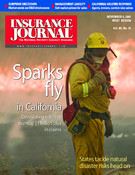Climate change is likely to increase the number of wildfires fueled by invasive weeds that are spreading throughout the Great Basin, researchers recently told a U.S. Senate subcommittee.
Researchers described a potential increase in the amount of cheatgrass and other invasive weeds that populate the region and have fueled wildfires that have burned hundreds of thousands of acres in the West.
Ecologist Jayne Belnap told a meeting of the public lands and forests committee that some climate change models predict average temperature increases of up to 11 degrees by the end of the century, as well as increases in precipitation and carbon dioxide levels. The combination means more cheatgrass and potentially more wildfires.
“There’s a lot of reason to expect (wildfires) will increase,” Belnap told the subcommittee meeting in Las Vegas. “The biggest reason is we’ll have drier soil, we’ll have drier fuels. … most climate models would project that they will increase.”
The Great Basin covers 73 million acres in five Western states. Just more than half of the region is public lands.
Several major fires this summer were exacerbated by the spread of the invasive weed, including the Murphy Complex blaze on the Idaho-Nevada border that burned an area larger than Rhode Island.
Belnap, a researcher with the U.S. Geological Survey, said such fires deposit nutrients into the soil that encourage the growth of cheatgrass.
The fast spreading, highly flammable alien weed has established itself across the West since it arrived from the Central Asian steppe in the 1800s as a stowaway on ships. Carried west in livestock rail cars, cheatgrass produces hundreds of pounds of seed per acre, overwhelming native grasses. It dries out faster than other grasses, leading to larger, more dangerous fires.
Federal authorities are working to set priorities, coordinate restoration of public lands and fight the spread of invasive species, said Mike Pellant, of the Bureau of Land Management Great Basin Restoration Initiative, a multistate working group. He called for a better coordination between states and a broader approach to solving the problem.
Pellant told the committee a plan intended to instruct land managers on the climate change issue was slated to be issued next year. He noted that increased atmospheric carbon dioxide, typically associated with climate changes, encourages the growth of cheatgrass that is particularly troublesome because it is less digestible and appealing to cattle.
Senate Majority Leader Harry Reid also testified at the meeting and called for increased renewable energy sources to prevent greenhouse gases from entering the atmosphere.
Topics Catastrophe Natural Disasters Wildfire Climate Change
Was this article valuable?
Here are more articles you may enjoy.


 Poorer Americans Dropped Federal Flood Insurance When Rates Rose
Poorer Americans Dropped Federal Flood Insurance When Rates Rose  Trump to Issue Order Creating National AI Rule
Trump to Issue Order Creating National AI Rule  North Carolina Sting Operation Alleges Roofer Damaged Shingles to File Claim
North Carolina Sting Operation Alleges Roofer Damaged Shingles to File Claim  State Insurance Legislators ‘Greatly Disturbed’ by Trump AI Regulation Order
State Insurance Legislators ‘Greatly Disturbed’ by Trump AI Regulation Order 


